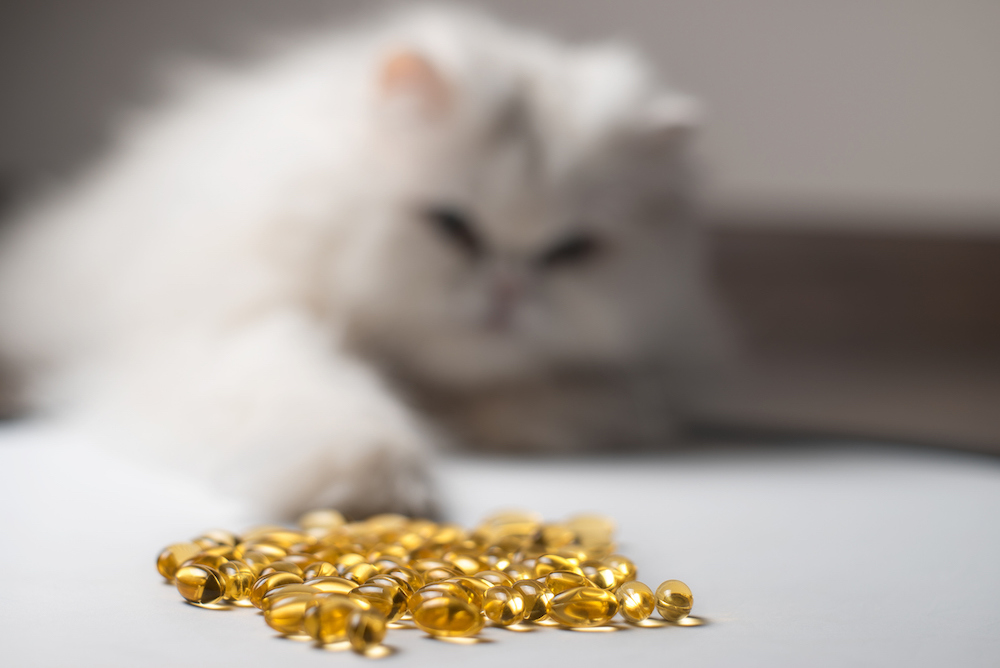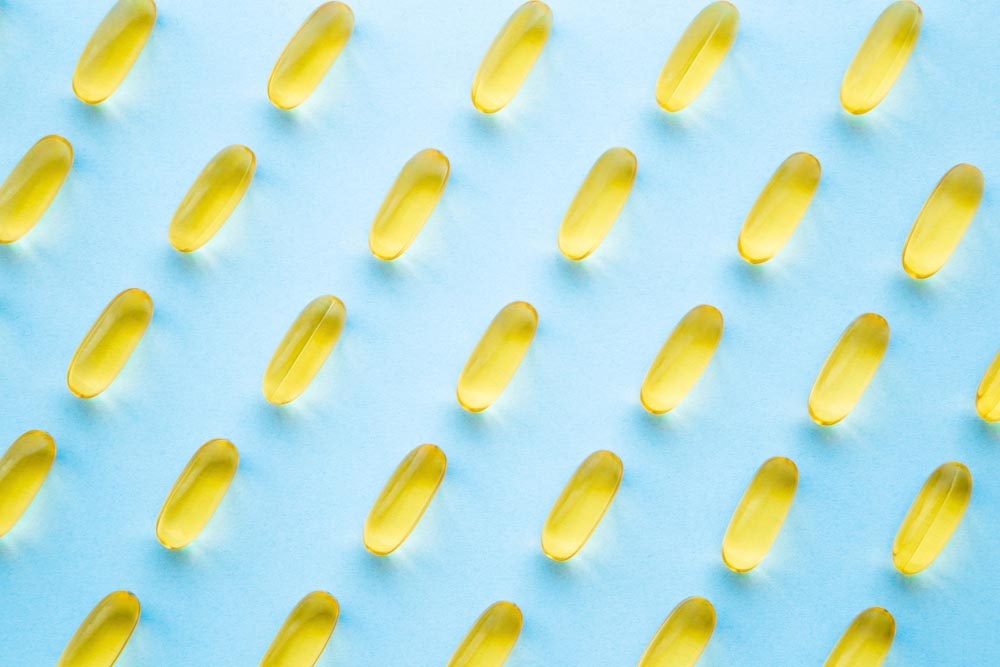Learn : Health & Wellness
How to Choose the Best Fish Oil for Dogs and Cats
Fish oil has been shown to have many benefits for both dogs and cats. However, with so many options, choosing the right fish oil supplement can be confusing. In this guide, we review the criteria and evidence behind four important factors to consider before choosing a fish oil supplement for your dog or cat: source, quality, natural vs. synthetic form, and dose.
What is the best fish oil source?
Not all fish oil is created equal and it is important to make sure you are sourcing the highest quality product for your beloved companion.
Traditionally, wild-caught salmon has been used for the production of many fish oil supplements. However, as predatory fish, there are increasing concerns about the accumulation of toxins and heavy metals, especially mercury.1,2 Furthermore, overfishing of salmon has raised concerns around sustainability and has lessened their omega-3 fatty acid content.1 Omega-3s are essential fatty acids, required in the diet of our pets, and the main beneficial component of fish oil! Farm-raised salmon was initially a popular alternative, helping to restore wild salmon populations. However, as the saying goes, you are what you eat. Since farm-raised salmon commonly eat grains, corn, and groundfish and don’t get the same exposure to algae and plankton as wild salmon, which is where fish derive their omega-3 content, you’ll often find lower levels of fatty acids in farm-raised fish.3,4 Since production and quality standards can alter omega-3 content of the fish and, overcrowding, chemical, and antibiotic use can bring rise to pollution, parasite, and ethical issues surrounding farm-raised salmon, the choice between wild vs. farmed salmon isn’t always easy.1
To address sustainability and toxicity concerns, more fish oil products are being produced with non-predatory smaller fish, with high fatty acid content. These fish, being so low on the food chain, do not experience accumulation of heavy metals and toxins to the same degree.1 Anchovies and sardines are great examples of fish to use, however, other good options include herring and mackerel.1
What makes a quality fish oil supplement?
Beyond noting the fish type, when buying fish oil, be sure to look for further indications of quality and production standards. High-quality fish oil products should come from a reputable company and be fully tested for heavy metals, oxidation, and other contaminants, preferably by a third party.1,2 Some fish oil products hold a National Animal Supplement Council (NASC) seal, which ensures the company partakes in random finished product quality testing, quality training, and a quality audit every 2 years.1 If companies can provide similar information from third-party labs this is also preferable over supplements with no quality control. Additionally, high-quality fish oil supplements should be regularly tested for and report levels of EPA and DHA. As these are the main active ingredients we care about and certain forms of fish oil are more susceptible to loss of activity.1
Furthermore, fish oil products, particularly from cod liver, containing vitamins A and D should more often than not, be avoided, especially for cats.3 Cats readily absorb vitamin A, and fish oil products containing vitamin A could, although rare, lead to absorption of toxic levels.2,5 For dogs, fish oil could also provide toxic levels of vitamin D.2,5 Finally since fish oil is sensitive to contamination and oxidation, product packaging can also be an indicator of quality. Aluminum or glass containers are good examples of containers that help maintain freshness, but with aluminum, there is the added shatter-free aspect.
What is the best fish oil supplement form?
Usually, fish oil for cats and dogs is “served” as soft-gel capsules or liquids. However, soft chews or bites can be an option too, but keep in mind those are multi-ingredient and can vary widely in the dose provided.
Most commonly, fish oil supplements contain oil in what’s known as the “natural” triglyceride form. This form is considered “natural” because it is the same form that our pets would ingest if they were to eat the fish themselves. However, in this form, the oil is only ~30% EPA + DHA by weight. As a result, to get an adequate dose of EPA + DHA, soft-gel capsules tend to be larger. For example, a soft-gel capsule that provides about 180mg EPA and 120mg DHA, would be 1200mg overall.1
Sometimes, fish oil supplements contain synthetic oil, known as the ethyl ester form. This form is developed to contain high concentrations (40-90%) of EPA + DHA. Sounds good, right? However, the downfall is that this high concentration is not only pricey, but this form may not be absorbed as readily.1,6 Finally, fish oil supplements can also contain oil in what’s known as the free fatty acids form, which is a form that’s been processed to contain concentrations of EPA + DHA between 55 - 80%. This form is relatively bioavailable and absorbed well, however, as the concentration of EPA + DHA increases, so does the price. Having said that, soft-gels capsules in this form tend to be smaller, due to the higher concentrations of EPA + DHA, and thus can offer more ease of administration.1
Can I give my pet fish oil for humans?
Unless otherwise instructed by your vet, it is not generally recommended that your pet take the human version of fish oil supplements. Many human products are flavored with citrus, that pets don’t appreciate, or can be sweetened with xylitol, which is toxic to dogs.7,8 Unflavored human products, can be safe for your pet, however, the biggest thing to consider is the differences in dose.9 Human and pet fish oil supplements will not only likely differ in dose but also additional additives, and animal supplements are specially formulated with your pet in mind. Nonetheless, if you plan on supplementing your dog with fish oil meant for humans, be sure to talk to your vet first for dosing recommendations and to make sure the product is safe.
How much fish oil should I feed my dog or cat?
The optimal dose of fish oil for dogs and cats is not fully known and varies with the condition. You should talk to your veterinarian before starting your furry friends on fish oil regardless, and they can help recommend the best dose to try for your pet’s needs.
Calculating the correct dose of fish oil for your furry friend can be tricky. Often, doses are provided as mg EPA+DHA (combined) per kg body weight.2 Metabolic body weight is also used in place of body weight, which for dogs is (bodyweight) 0.75 and for cats is (bodyweight) 0.67. A 10kg dog and 5kg cat are often assumed to allow consistent comparisons of dose to be made.2,10 Other times dose might be listed as grams (EPA + DHA) per 1000kcal diet, or some products might list the dose as the omega-6 to omega-3 ratio provided.2
The fancy table below overviews some published current dosing recommendations for the treatment of different clinical disorders for dogs and cats, based on current research. The discrepancy of established research between dogs and cats is further emphasized by this table. The metabolic dose of EPA+DHA is shown in mg/kg of body weight0.75 for dogs, and mg/kg of body weight0.67 for cats. The actual dose given to your pet is found by multiplying the metabolic dose by your pet's weight in kg0.75 for dogs and kg0.67 for cats, i.e. 115mg/kg x 10kg0.75 ≈ 646mg EPA + DHA for 10kg dog with a heart issue. Example doses are provided for a model 10kg, 20kg, and 30kg dog and 5kg, 7.5kg, and 10kg cat.
But to make it easy for those not so inclined to pull out the scientific calculator, you can roughly assume the following:10
- For most joint conditions a dose of 3 grams of EPA + DHA per 1000 calories is recommended.
- For other conditions, a dose of at least 1 gram of EPA + DHA per 1000 calories is recommended.
Overview of Recommended Dosages EPA + DHA for Dogs & Cats:
|
DOGS |
Metabolic Dose EPA + DHA (mg/kg of body weight0.75) |
10kg Dog: Actual Dose (mg) |
20kg Dog: Actual Dose (mg) |
30kg Dog: Actual Dose (mg) |
|
Heart Conditions |
115 |
646 |
1088 |
1475 |
|
Kidney Disorders |
140 |
790 |
1325 |
1795 |
|
Joint Conditions |
310 |
1745 |
2932 |
3974 |
|
Skin Diseases |
125 |
700 |
1182 |
1602 |
|
Gastrointestinal Disorders |
125 |
700 |
1182 |
1602 |
|
NRC Adequate Intake/Recommended Allowance |
30 |
169 |
284 |
385 |
|
NRC Safe Upper Limit |
370 |
2080 |
3500 |
4743 |
|
Reasonable Dose |
50 - 75 mg/kg body weight |
500 - 750 |
1000 - 1500 |
1500 - 2250 |
|
CATS |
Metabolic Dose EPA + DHA (mg/kg of body weight0.67) |
5kg Cat: Actual Dose (mg) |
7.5kg Cat: Actual Dose (mg) |
10kg Cat: Actual Dose (mg) |
|
NRC Adequate Intake/Recommended Allowance |
2.5 |
7.3 |
9.6 |
11.7 |
|
NRC Safe Upper Limit |
Not established. |
Not established. |
Not established. |
Not established. |
|
Reasonable Dose |
30 - 50 mg/kg body weight |
150 - 250 |
225 - 375 |
300 - 500 |
Table adapted from Bauer 2011 & Lenox 2016
If you haven’t seen any response in your pet’s signs at the starting dose, for example, improved mobility in arthritis, you can always go higher. Just watch out for side effects of reduced enthusiasm in food or in loose stool. And don’t forget to start slowly when incorporating it into the diet, and that it adds calories to the diet.
Before starting your pet on any supplement, it's best to talk to your vet first. We hope this guide arms you with knowledge and information that can you select the best fish oil for your dog or cat.
References
- Kwochka, K. W. Fatty acids in veterinary dermatology and beyond: mechanism of action, clinical indications and quality. in SPONSORS OF THE 8 TH WORLD CONGRESS OF VETERINARY DERMATOLOGY 216 (pdfs.semanticscholar.org, 2016).
- Lenox, C. E. Role of dietary fatty acids in dogs & cats. TVP Journal 83–90 (2016).
- Lenox, C. E. Timely Topics in Nutrition: An overview of fatty acids in companion animal medicine. J. Am. Vet. Med. Assoc.246, 1198–1202 (2015).
- Farmed vs. Wild Salmon :: Washington State Department of Health. Available at: https://www.doh.wa.gov/CommunityandEnvironment/Food/Fish/FarmedSalmon. (Accessed: 8th October 2019)
- Linda P. Case, Leighann Daristotle, Michael G. Hayek, Melody Foess Raasch. Nutrition and the Heart. in Canine and Feline Nutrition - A Resource for Companion Animal Professionals 3, 511–519 (Mosby Elsevier, 2011).
- Lawson, L. D. & Hughes, B. G. Human absorption of fish oil fatty acids as triacylglycerols, free acids, or ethyl esters. Biochem. Biophys. Res. Commun. 152, 328–335 (1988).
- Fish Oil for Dogs Hair, Skin and Coat | Benecoat®. Available at: https://www.marvelousproducts.com/fish-oil-for-dogs. (Accessed: 8th October 2019)
- John Gilpatrick Jennifer. 6 Dangerous (and Surprising) Items That Contain Xylitol | petMD. Available at: https://www.petmd.com/dog/emergency/poisoning-toxicity/6-dangerous-and-surprising-items-contain-xylitol. (Accessed: 8th October 2019)
- Weil, A. Fish Oil for Dogs - Omega 3 for Dogs | Dr. Weil. DrWeil.com (2007). Available at: https://www.drweil.com/health-wellness/balanced-living/pets-pet-care/fish-oil-for-dogs/. (Accessed: 8th October 2019)
- Bauer, J. E. Therapeutic use of fish oils in companion animals. J. Am. Vet. Med. Assoc. 239, 1441–1451 (2011).



 Evidence-Based Guide to Fish Oil Health Benefits for Dogs and Cats
Evidence-Based Guide to Fish Oil Health Benefits for Dogs and Cats